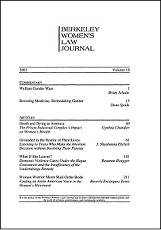Rebecca J Cook, Bernard M Dickens

Abstract
This paper presents an overview of the dimensions of unsafe motherhood, contrasting data from economically developed countries with some from developing countries. It addresses many common factors that shape unsafe motherhood, identifying medical, health system and societal causes, including women’s powerlessness over their reproductive lives in particular as a feature of their dependent status in general. Drawing on perceptions of Jonathan Mann, it focuses on public health dimensions of maternity risks, and equates the role of bioethics in conscientious medical care to that of human rights in public health care. The microethics of medical care translate into the macroethics of public health, but the transition compels some compromise of personal autonomy, a key feature of Western bioethics, in favour of societal analysis. Religiously-based morality is seen to have shaped laws that contribute to unsafe motherhood. Now reformed in former colonizing countries of Europe, many such laws remain in effect in countries that emerged from colonial domination. UN conferences have defined the concept of ‘reproductive health’ as one that supports women’s reproductive self-determination, but restrictive abortion laws and practices epitomize the unjust constraints to which many women remain subject, resulting in their unsafe motherhood. Pregnant women can be legally compelled to give the resources of their bodies to the support of others, while fathers are not legally compellable to provide, for instance, bone-marrow or blood donations for their children’s survival. Women’s unjust legal, political, economic and social powerlessness explains much unsafe motherhood and maternal mortality and morbidity.
Cook RJ, Dickens BM. The injustice of unsafe motherhood. Dev World Bioeth. 2002 May;2(1):64-81



